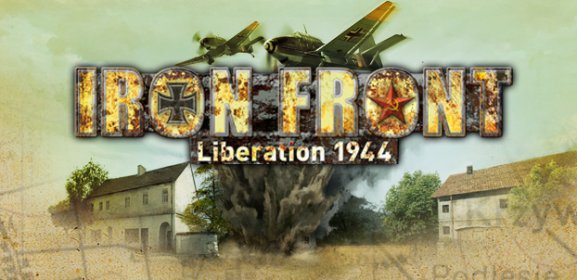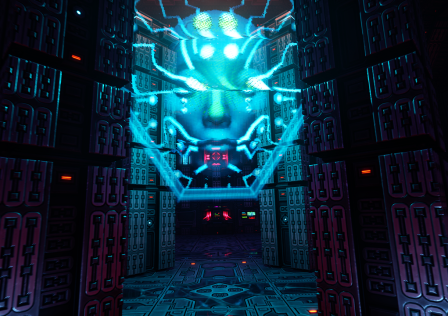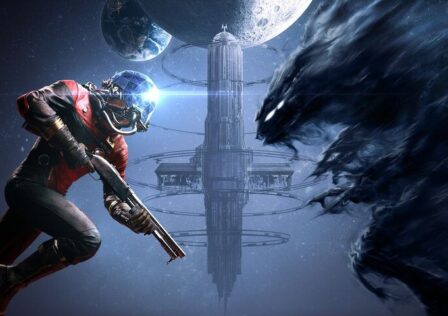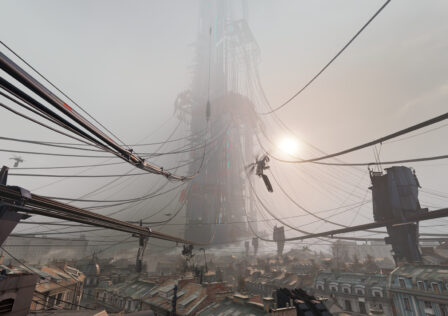v It is an authentic WWII FPS that falls into the category of “simulator”. At this point, the only similar games are those from Bohemia Interactive Studio. If you have never played any of their games, you’re in for a totally new experience compared to other military themed FPS.
Some have a hard time understanding how Iron Front can be so much different than the traditional FPS. But trust me, it is. From the ballistic physics to the command system, the way fatigue is factored in, and even the movement feels different than your normal FPS. But don’t let this scare you off, it isn’t too hard to adapt to and it’s hardly clunky by any means. Games like Iron Front should definitely be played, just to see how the FPS genre should advance (at least in the military/war theme).
Some of us here at GND were more than impressed by ArmA 2 and its expansions. Lets see if Iron Front, one of the only non-Bohemia games of the same genre, can also impress.
First Impressions
As far as I know, Iron Front: Liberation 1944 is only available on Steam and on Bohemia’s online store. The retail price is $29.99, although Steam has an offer of $26.99 until June 1. This is much better than the usual $50-$60 FPS, which doesn’t have nearly as much content as Iron Front.
As the name indicates, it is set during WWII on the Eastern front. Both German and Soviet campaigns are playable, and the game takes you across Poland and Ukraine. Four maps are included which is quite a lot for a game of this size. Two of them are huge, easily on the same scale as the 164 km^2 “Takistan” Map found in ArmA 2: Operation Arrowhead. To give you a better perspective, 164 km^2 is over 4x the size of Skyrim which is about 38 km^2.
To be honest, it’s best to look at Iron Front: Liberation 1944 as if it were a standalone WWII expansion to ArmA 2. Obviously it isn’t, since it has a different development team and publisher, but the games have the exact same UI and controls. The menu design is quite nice and simplistic, realtime 3D which helps with adjusting graphics options by allowing you to view your changes and frame rate differences. A mod loader is located in the main menu, under “Expansions”.
Here is where Iron Front, just like ArmA 2, really shines in the beginning. Customization is far above the norm – you can change each key binding like usual, but this game lets you assign various key combinations to each function. Thankfully mouse smoothing can be raised or lowered.
The control configuration also lets you know if any key or key combo is already in use. Excellent!
The options menu lets you change the language, enable or disable subtitles, and change the blood amount. “Aiming deadzone” refers to the amount screenspace in which you can aim, before the camera moves. Lowering it all the way makes it like a normal FPS, in which your gun is always centered on your screen. Increasing it lets your gun move around freely. Increase it a little bit such as here, for more realism. Head bob is adjustable as well, and like ArmA 2, is realistic headbob which looks incredible. No FOV slider is included, or needed since this is supposed to be a realistic game.
Difficulty parameters can even be adjusted. More games need this.
Iron Front: Liberation 1944 consists of far more content than your average shooter. Not only does it have two campaigns (Soviet and German), but there are two versions of each of those campaigns – English voice over, and authentic ones (Russian and German respectively). This is great, as I prefer authentic voice acting. It also includes three scenarios, or shorter missions, one of which is a showcase of all character models, vehicles, and equipment. These scenarios and the campaign can be played by yourself, or cooperatively online with up to and over 32 players. Here is the complete server browser, something which sadly isn’t common these days but was common many years ago.
So my first impressions are quite positive. Those of us who have played ArmA 2 will feel right at home when it comes to the UI, customization, and controls of Iron Front. Now let’s look at the content itself.
Gameplay
Iron Front: Liberation 1944 lets you play as Germans or Soviets, giving you different perspectives on WWII. Throughout the campaign you’ll encounter varieties of situations, play as infantry or in vehicles or as a commander, and you’ll be promoted which changes your role.
A typical dialogue before the action begins.
There are many detailed mission briefings throughout both campaigns.
Brief cutscenes will be encountered as well, but don’t expect any epic cinematic campaigns.
Below shows the included maps. The scale of some of them are rivaled only by the ArmA games.
Small
Medium
Large
XL
Weapons are highly authentic for each side, as much research had gone into them and this engine is known for its realistic ballistic physics. On top of this, aim sway is a factor for all weapons, and aim sway increases when you’re fatigued or wounded. You can even compensate for range when aiming down the sights or scope. Little changes like this make it much harder to acquire targets. You won’t be using pistols to take out 200m targets like in other FPS games. In Iron Front, you’ll encounter various pistols, submachine guns, rifles, machine guns, and even portable artillery and other crazy weapons that you’ll only get to use in this game or in BIS games. The next few images were taken in the long training sessions in the campaigns, nothing skimmed upon there.
Some machine guns must be dismantled in order to be transported, just like in reality. Surprisingly that does not apply to this MG42.
Obstacle courses are present in the training sections of the campaign. You have to run, crawl under, and climb over obstacles. With this being said, the step-over function could improve. It’s very awkward as you can use it even if there is no obstacle in front of you, and it doesn’t work with taller obstacles. The animation for stepping over in 3rd person shows clipping issues.
Training exercises include grenade practice as well.
You even train with AT equipment.
This guy looks ready. Are you?
In combat, you’ll encounter and use even more unique weapons.
What’s really amazing about Iron Front is the intensity provided by the realistic gameplay. You can’t just sit back and run-and-gun like most FPS games… Iron Front will put you on your toes and make you care when you or your squad mates get hit. Not because of character development, but because you actually have to try to survive and you can’t do much on your own. If you try to be Rambo, you’ll end up here. You can in fact heal yourself if you’re a medic, or have a medic heal you.
When on an assault or defense, you’ll end up being extra cautious.
When on the move in a hostile area, you sprint.
When under fire, you take cover.
It’s nice to see these basic combat principles actually take affect in a video game. Iron Front also consists of many radio commands, from simple replies like in the picture below, to commands to each of your squad members, or commanding large scale units on a map similar to RTS games.
The inventory is nice, a bit different than ArmA 2.
There are over 35 controllable vehicles in the game, from cars to trucks, various armored vehicles, and even airplanes. All of which are supposed to have an authentic feel to some extent, but obviously the game is no driving or flying simulator. Vehicles do have fuel consumption, and thankfully the driver doesn’t do all of the work in armored and armed vehicles. Gunners get their own seats and have to do the work themselves. Airplanes also have a longer startup time to be more authentic – you can’t just get in and start speeding down the runway. The attention to detail is unrivaled by all but BIS games.
The included mission editor/creator is the same as ArmA 2 and ArmA 2: Operation Arrowhead. It is a very advanced editor, but you can create basic missions very quickly. Inside you can spawn and customize individual units or groups (people, animals, vehicles, etc.), you can spawn and edit/move triggers, AI navigation waypoints, create objectives, and much more. Refer to this guide when using the editor.
Multiplayer mode has its own custom missions, and is usually played cooperatively with up to and over 32 players, but you will probably find PvP servers as well. It uses BattlEye anti-cheat, which should prevent more cheaters as it is a less common type of anti-cheat compared to PunkBuster and VAC. Unlike many modern multiplayer games, LAN support is included. Online you also get many different channels to communicate on, VOIP with optional push to talk, text chat, etc. The multiplayer is just complete, unlike many mainstream games. Netcode seems fine, lag is less of an issue compared to some mainstream games like Battlefield 3.
The only problem I have with the gameplay is the AI. Friendly units are slow to follow your commands, which gets really annoying. Apart from this, the gameplay is phenomenal and like ArmA 2, it represents how some FPS games have advanced, even if most haven’t.
Audio & Visuals
The grass looks great, and it is moved around by people crawling through it. The overall polygon count seems great. When moving, the game can look incredible due to the realistic headbob and motion blur. Don’t forget to enable SSAO if you have a powerful PC (discussed in the First Impressions section).
Particle effects are quite good, lighting is fully dynamic and the overall shader quality is as excellent as in ArmA 2. MSAA is the included AA option, and the view distance slider lets you see terrain up to 10000 meters away. Keep in mind that if you increase this and “3D resolution” too much, it will be the hardest game to run right after ArmA 2, especially if you enable SSAO. Aside from the trees, the textures and grass pop-in are disappointing and need improvements.
The sounds are a mix of both great and not so great. There is a lot more positives than negatives when it comes to sounds – the authentic voices are much better than English with an accent, and most of the sound effects are excellent. Footsteps are audible, vehicles are very loud, and 3rd person gunshots and explosions will rock your world. But for some reason, your own gunshots in 1st person have lower volume than just about everything else.
Overall sound quality is good, but needs that one critical improvement. Visual quality needs some tuning – increased vegetation view distance, and ironing out some engine bugs will help with the glitchy trees.
Conclusion
This was a pretty lengthy review, but definitely needed for a game like Iron Front: Liberation 1944. The single player campaigns are nothing great, but enjoyable. This game really shines in cooperative multiplayer, preferably in custom missions thanks to the incredible mission editor, and in private servers with friends in order to get some real communication going. However, some annoying bugs especially occasional CTDs are going to hurt the game’s score.
- Presentation: The UI is great, and the amount of customization in Iron Front should be taken note of by other game developers. However, some stability problems (occasional CTDs) will make me take off two points here. 3/5
- Story: Iron Front is not supposed to be a story driven game so I’ll go easy on it, like I normally do for military themed FPS. A story for a game like this is not needed, especially since one of the biggest attractions for it is custom coop missions. 3.5/5
- Gameplay: I would go with a perfect score here if AI was improved. But as it stands, 4.5/5. Friendly AI should obey commands better when under intense situations.
- Audio & Visuals: Iron Front could have looked amazing, if it weren’t for some engine bugs and low res textures. I don’t know why SSAO was disabled by default but I won’t hurt its score for that. I will hurt its score for the pop-in issues, glitchy trees, character models and animations could be improved, and because first person gunshots aren’t typically loud enough. 3.75/5
- Lasting Appeal: Iron Front gives you two campaigns, some extra missions, up to 32 player coop, and a top of the line mission editor. It doesn’t get much better than this. 5/5
- Overall: 79/100 (Decent)












[…] own, created by its predecessor Operation Flashpoint. The only non-Bohemia title in this genre is Iron Front: Liberation 1944, which uses the same engine as ArmA 2 and is essentially a standalone, non-official WWII expansion […]